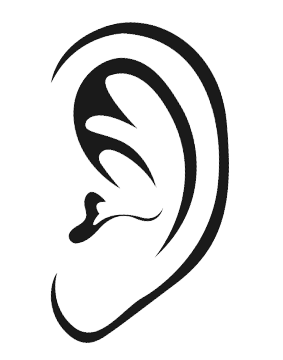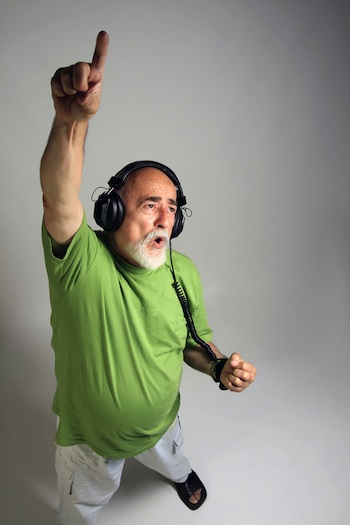Do you love music? Are you learning to play music?
Whatever age you are, your musicality will benefit from ear training.
Whether you start with basic skills like clapping back a rhythm or singing a song by rote, or you develop more advanced aural skills like complex harmonies or music dictation, you can use ear training to improve your musical ear.
Learning how to develop your ears may seem a difficult task. You might even be worried that you’re tone deaf. But once you understand what ear training actually involves, you will realize that you have already been training your ears your entire life! Actively practicing ear training is just a more effective way to do it.
If you’ve only just picked up an instrument as an adult beginning to learn music, you might be surprised to find out that everyday activities like singing in the shower are the first steps in training your ears…

What is Ear Training?
Even if you have never heard the term “ear training”, if you have performed as a musician or have ever taken a music lesson, the chances are that you have worked on ear training.
“Aural skills” are musical listening skills that develop your ability to hear specifically in regards to music and sound, and ear training is the process of developing these skills.
For example, if you can listen to a song on the radio and play or sing it back, you have been training your ears. If you can play back a rhythm, orcan tell the difference between different types of sound effects, you have been training your ears.
Developing your aural skills with ear training benefits you in a number of ways including improving memory, increasing confidence, developing your ability to improvise, and exercising your voice and intonation. Learn more in this article about learning music later in life.
Here is an easy ear training exercise:
- Turn on the radio to a familiar tune.
- Listen to the tune for a few minutes.
- Now turn off the radio.
- Can you imagine hearing the melody in your head?
- Now try to hum the melody out loud.
Congratulations, you just practiced ear training!
This particular skill is called audiation: the ability to retain a musical sound when the sound is no longer present.
You can take this ear training exercise one step further by playing back the melody on your instrument or singing the words. You are developing your musical ears and your musical memory.
10 Ear Training Tips for Adult Beginners
As an adult first learning music you may be concerned that your ears are not as developed as they would be if you’d started sooner. Don’t worry! You can develop your ears with ear training at any time in your life, and a musician who starts late and actively practices ear training can easily end up with far better ears than a musician who started young but neglected ear training.
There are a wide variety of topics you can study in musical ear training, each of which develops different listening skills. You can explore different types of ear training to find those which suit your musical life.
To help you get started, here are 10 tips for beginning ear training as an adult:

1. Start Simple: Learn active listening
Don’t worry about being a Mozart on day one! Start with simple ear training exercises.
Take a lesson from composers John Cage and Pauline Oliveros: close your eyes to take in your sound environment.
Ask yourself questions like:
- What do you hear? Work on differentiating between low sounds, high sounds, talking, animal noises, machines, etc.
- Are the rhythms fast or slow?
- Are the sounds loud or quiet?
- Where are the sounds located? Are the sounds above you? Below?
Becoming aware of your surroundings like this enhances your aural skills and it’s an exercise you can do every day.
2. Test your hearing
If you find that you have difficulty hearing people speak in crowded rooms, cannot hear high pitches, or have to constantly ask people to repeat themselves, then you might want to test your hearing.
Check out the Action on Hearing Loss site for an online hearing test and consult your physician.
If you are able to enjoy the music you listen to, that’s a good sign your ears are still strong enough to become an able music-maker! Testing your hearing is a good way to confirm this and let you know if there are any issues to be aware of as you learn music.

3. Test your existing listening skills
How good are your ears? You might know more than you know!
Take a simple Intro to Ear Training quiz and discover your ear training level. From there you can pursue the ear training that you need.
4. Let rhythm guide your learning
Although people think of rhythm as a “natural” ability, the truth is that your rhythm skills can be learned and improved.
Honing your rhythmic skills is often one of the simplest ways to begin your ear training journey. Almost anyone can clap along with a favorite tune!
Test your rhythm skills online with the Theta Music Trainer Flash Rhythms game. Learn more about rhythm ear training here at EasyEarTraining.com and test your rhythm skills with the Aural Workshop Rhythm Quiz.
5. Master the melody
Improving your musical sense of relative pitch is key to understanding melody and learning how to sing and recognize intervals is a great way to do this.
Download the free Step and Half: First Steps app to learn the basics of interval training and how to transcribe and play tunes by ear using intervals.
6. Step up to the harmony
Once you are comfortable with rhythm and melody, have fun with chords.
Chord ear training exercises and interactive apps like Chordelia help you master triads quickly.
7. Have ear training fun with a friend
Music is always more fun with a friend! Rope in your band next time you work on a harmony exercise or turn a night of karaoke into a fun ear training exercise.
Test the rhythmic chops of your drummer, learn basic dictation with your kids or grandkids, or enjoy taking a free ear training course with your spouse.

8. Connect your ear training with your instrument or singing practice
Apply your new ear training skills to your instrumental or vocal skills. After a few weeks, you will find that your improved ear training has really enhanced your musicianship!
9. Learn about audio
Ear training as an adult beginner doesn’t just involve rhythm, melody, and harmony. For those involved in music production or performance, learning the difference between different audio effects and how to recognise frequencies are useful skills.
Do you know the difference between reverb and echo? How do you EQ your band’s new demo?
Developing your ear for audio frequencies and effects provides a valuable counterpart to musical ear training.
10. Keep challenging yourself
Once you have moved beyond rhythm, melody, harmony, or audio effects, continue to challenge yourself. Pick a new area and stretch your ears in a different direction. Learn how to dictate complex harmonic progressions, teach yourself sound synthesis, or compose original music.
There are countless ways to move beyond the basic and become an ear training guru! The online Ear Expansion course introduces you to 10 key areas you can incorporate into your own musical ear training.
Time To Start!
Learning how to develop your ear training skills as an adult musician is fun and rewarding. There are numerous benefits like enhanced memory and focus attributed to musical skills.
Start simple and move through different levels of ear training: sounds, rhythm, melody, harmony, audio effects….
Have fun with ear training!
We’d love to hear your story. Share your personal experiences with ear training in the comments below!







